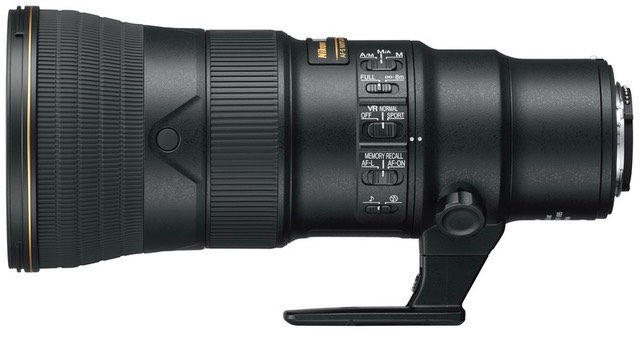
What is It?
The 500mm f/5.6E PF ED VR is the second lens from Nikon using Phase Fresnel optical design (thus the PF in its name). The first was the 300mm f/4E, which turned out to be a real winner of a lens and is one of my favorites for travel.
The whole idea behind PF is to reduce the amount of glass in a lens, and thus the overall weight as well. Nikon goes a bit further than that by also designing the PF lenses using an optics approach for telephoto that produces a somewhat shorter lens with more rearward glass, too.
The phase fresnel element is up towards the front of the lens, and is one of the biggest elements. It's thin depth is where both the size and weight benefit mostly comes from, though the fact that it is only f/5.6 maximum aperture also helps. The only drawback to using the fresnel approach is what happens when you have strongly backlit—and particularly point light sources behind the subject—scenes. The "spreading" aspect of the fresnel pattern can result in a back flare that's broad and sometimes ugly.
Fortunately, most of us that use a 500mm lens aren't shooting things with point light sources immediately behind our subjects. We're mostly shooting front-lit wildlife and sports, and that's exactly what this lens was designed for.
Most people will be surprised to find the 500mm f/5.6E PF comes in at almost the length and weight of the 70-200mm f/2.8E. At 9.33" (237mm) in length and 3.2 pounds (1460g), the 500mm is only about 2" longer than the 70-200mm f/2.8E from mount to bayonet for the hood, and about the same weight. That was probably the biggest surprise to me: any bag where my 70-200mm fit, the 500mm tended to do so also. That's actually changed the bags I use when I'm just using the PF and shorter lenses. For example, I fit a complete sports kit into the new Gura Gear Kiboko 2.0 16L backpack pretty easily. Smaller pack, less airline hassle.
By comparison, my 500mm f/4G is 15" (387mm) long and weighs 109 ounces (3090g), and it barely fits in my larger Kiboko G26.
At 19 elements in 11 groups, this isn't a simple lens optically. Indeed, all of the Nikkors lately have a bit more complexity than Nikon lenses used to have in the same category. We've got Nano coating and 3 ED elements to help keep internal bounce-back flare and lateral chromatic aberration in check. As with most recent Nikkors, we also have a weather-resistant design and fluorine coating on the front element to shed the elements.
Minimum focus is a decent 9.8' (3m). That's nearly two feet better than the 500mm f/4E. If you like diffraction, the 9-blade aperture diaphragm will take you all the way down to f/32.
You can add the Nikon teleconverters to the lens. The TC-14E III puts you at 700mm f/8 effective. That's as far as you can go and get any usable autofocus on the DSLRs. Surprisingly, I found I could use the TC-20EII (1000mm f/11) on my Z cameras and get useful autofocus. But when you put a TC on the lens you're a long way from the sweet spot for focus systems (typically around f/4), and on the DSLRs you're going to have limited sensor areas available to use, too. You can definitely make the lens hunt for focus in low light with the TCs on, so be forewarned.
The 500mm f/5.6E comes with an array of controls:
- A/M, M/A, and M switch to control the Focus Mode.
- Full, 8m to Infinity switch to limit focus hunting.
- VR Normal, Sport, Off button matches all the latest Nikkors (and now Z bodies).
- Memory Recall, AF-L, or AF-On switch for the Lens Fn buttons.
- Beep on/off button.
- Lens Fn buttons just in front of the focus ring.
VR is stated to be 4 stops CIPA.
Up front we have a 95mm filter ring and a bayonet mount for the included HB-84 lens hood. (If you didn't know, Nikon sells a 95mm circular polarizer.) Like all the long telephoto lens hoods, this one is big; keeping it on the lens makes the lens look much more like the length you were expecting ;~). This is a regular plastic type bayonet hood, thankfully, not the finicky screw-lock carbon fiber rigs you get with the exotics. The hood can be reverse mounted on the lens for transport.
Size isn't the only thing the 500mm f/5.6E PF has in common with the 70-200mm f/2.8E: the two lenses use the same tripod collar foot. If you've bought an accessory foot from RRS or Kirk for your 70-200mm, you'll find it works on the 500mm, too. That was a pleasant surprise, though since I often use my 70-200mm and 500mm together I still needed a replacement foot with an Arca-style plate on it. Only difference is, now both lenses use the same part, so I don't have to keep track of which is for which (I often travel with the foot off, as it allows me to tighten the space the lenses take up in the pack).
Remember, this is an E lens, so it has an electronically controlled aperture, not a mechanical link. That means that the 500mm f/5.6E PF will be essentially a “maximum aperture only lens” on cameras made prior to the switch. That includes the F6, D1 series, D2 series, D40, D40x, D50, D60, D70, D70s, D80, D90, D100, D200, and D3000 bodies (everything after those bodies in each line is fine). Nikon erroneously labels these older cameras as “incompatible” with E lenses, when it really should be “losses functionality."
The 500mm f/5.6E PF is made in China and sells for US$3600. It comes with the fold-over flap CL-M5 lens case. It's been on back-order status in most locales pretty much since it first appeared in fall of 2018.
Source of the reviewed lens: purchased via NPS Priority Purchase
How's it Handle?
The good news? This is a truly hand-holdable 500mm. Meanwhile, the 500mm f/4 is hand-holdable only by sadists. The 200-500mm f/5.6E is an awkward lens for hand-holding, particularly if you ever try to zoom. The 500mm f/5.6E PF? Just like a slightly bigger 70-200mm, and you know you've hand-held that ;~).
Of course, by the time you add a DSLR body, you're probably at 5 pounds (over 2.2kg), so you're going to want relief from time to time. This is one of those lenses that BlackRapid straps were made for. Which is exactly how I've been carrying it in the field.
On the DSLRs the balance is fine: much of the weight is back towards the mount-end of the lens. I was surprised to find that the balance also seemed fine with the Z series cameras using the FTZ adapter. One reason for that is your left hand position is going to probably be up on the focus ring or just behind it, and that's a very balanced position for all the camera/lens weight as the center of gravity is between your hands.
I didn't like the faux knurled ring up at the very front, though. It feels too much like a focus ring, and I do a lot of things by feel (eye always at the viewfinder). It could have simply been plain rubber and I wouldn't have an issue.
The focus ring on my sample is very smooth, and goes from near to far in a bit over a quarter turn.
All the switches can help make the lens even more useful with a bit of study. I like that Nikon didn't wimp out here and gave us basically the full set of controls that we get on the exotics.
How's it Perform?
Focus: okay, here's where we see a difference in our three choices at 500mm. The 500mm f/4E is snappy fast with focus on the most recent bodies (note that many earlier Nikon DSLRs have a bit of a delay before telling the lens what to do, notably the D3 and pre-D3 DSLRs). A long traverse from infinity to close focus stays snappy on that lens; about as snappy as you could expect from such a long focal length.
The 200-500mm f/5.6, meanwhile, is well known to be a slow-to-initial-focus lens. It tracks quite decently once focus is established, even on fast-moving subjects, but the in-lens motors of that lens take some time to make large moves.
The 500mm f/5.6E PF is comfortably in between those two, and if anything, closer to the 500mm f/4 than the 200-500mm f/5.6. I can clearly sense the difference in long focus pulls between the f/4 and the PF, so I don't have to measure them to know they're not the same. Yet I really didn't see any shooting circumstances where I felt this was a real liability. I could, however, see an occasional out-of-focus frame in sequences where I moved framing quickly to a different subject (happens a lot in some sports, but can happen if you're tracking multiple BIFs at different distances, too). Still, the lens caught up fast enough that it was usually only one frame that was missed.
Once focus is established, the lens is excellent on staying with the subject, pretty much matching the f/4 exotic, no matter how fast it is moving.
Overall, then, I'd judge the focus performance to be very, very good, just not great. As I moved back and forth between another exotic (my 400mm f/2.8) and the 500mm f/5.6E PF, I kept getting reminded that I needed to pre-establish focus just a teeny bit earlier with the PF. You adjust to this quickly, though.
Sharpness: we have three ways to talk about this: (1) on its own; (2) against the 500mm f/4; and (3) against the 200-500mm f/5.6. Nikon's published MTF figures for the lens look like a flat line, much like the 500mm f/4, so most of us had our fingers crossed when we pre-ordered this lens.
Just to be clear, Nikon's MTF charts are theoretical without diffraction impacts, not measured, and they only show the widest aperture at modest spatial cycles (10pmm and 30pmm). Thus, you always have to take those charts at face value, and verify that a real lens does what the charts suggest in actual photography.
So, here we go.
As with most recent Nikkors, we once again have excellent central sharpness, and that extends out into the corners in ways we never used to see, even with the exotics. This new lens is sharp right from f/5.6, and it still has punch out into the corners on the 45mp cameras.
Compared to the 200-500mm f/5.6: the 500mm f/5.6E has more contrast and higher acuity in the center by a modest amount, but it has far more contrast and acuity as you work your way across the frame and into the corners.
Compared to the 500mm f/4: I had to check this a couple of times (which should tell you something). Why? Because even a small miss in focus plane is enough to distort the results one way or the other.
I think what I see is this: the 500mm f/4 has just a bit more contrast and definition in very fine detail in backlit situations. That shouldn't surprise you, as the Achille's heel of the phase fresnel approach is when you have strong backlight: there's that spreading flare effect that occurs and can't be overridden.
That said, in front-lit situations I'm not sure I can tell a difference between the two at 500mm f/5.6. You'd just have to say that sample error could be higher than anything I might be able to measure or see.
Another surprise: there's very little edge falloff to sharpness, particularly wide open and at f/8.Technically, f/8 is the best aperture on this lens, but it does just fine wide open.
Surprisingly—if you can manage focus at f/8—the lens still looks pretty darned good with the TC-14EIII attached. Like the 300mm f/4E PF, the 500mm f/5.6E PF seems to tolerate teleconverter use very well. Expect to lose some acuity, but I'm impressed with what the combo does. Plus remember that you may be getting down into diffraction zone with the high megapixel count cameras. So there's just that little bit of edge spread that creeps in. Indeed, the 500mm f/5.6 with the TC reminded me a lot of the 200-500mm f/5.6 just out from the central area: usable, but not optimal.
Remember, though, that at f/8 maximum effective aperture (500mm+TC1.4EIII) you're highly restricted to what focus sensors are in use on the DSLRs. You become quite "center focused."
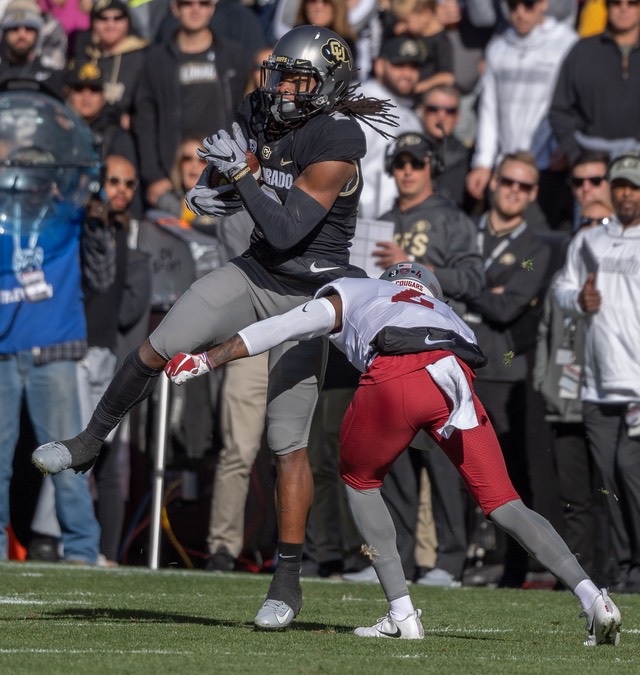
Sure, when you're shooting all the way across the field you just can't blur the background as much when you can only go to f/5.6. But...
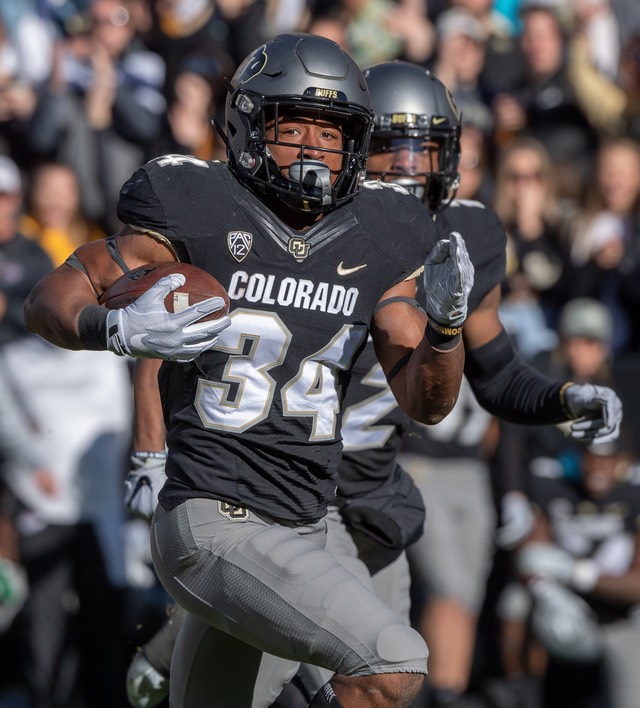
Get the right subject distance and that 500mm starts to make for some good isolation. This image is one of 72 images taken from handoff to score. And yes, the 500mm kept the focus the whole time. Well, at least until the ref got in front of me, and then I have some nice stripes that are in focus...Yeah, I know you want to see some more...
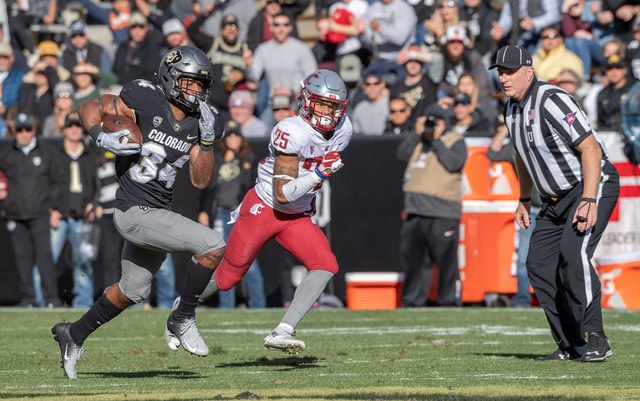
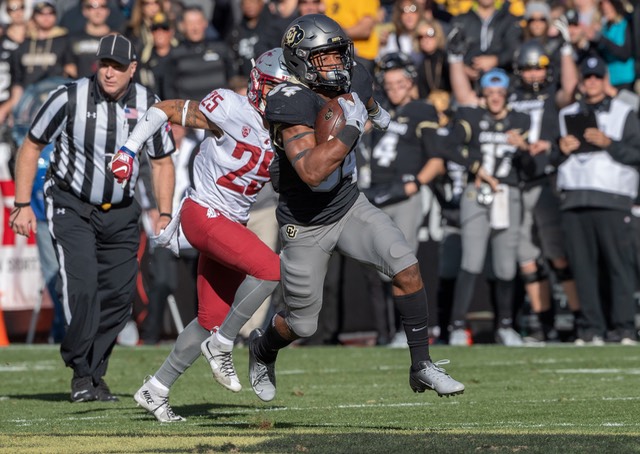

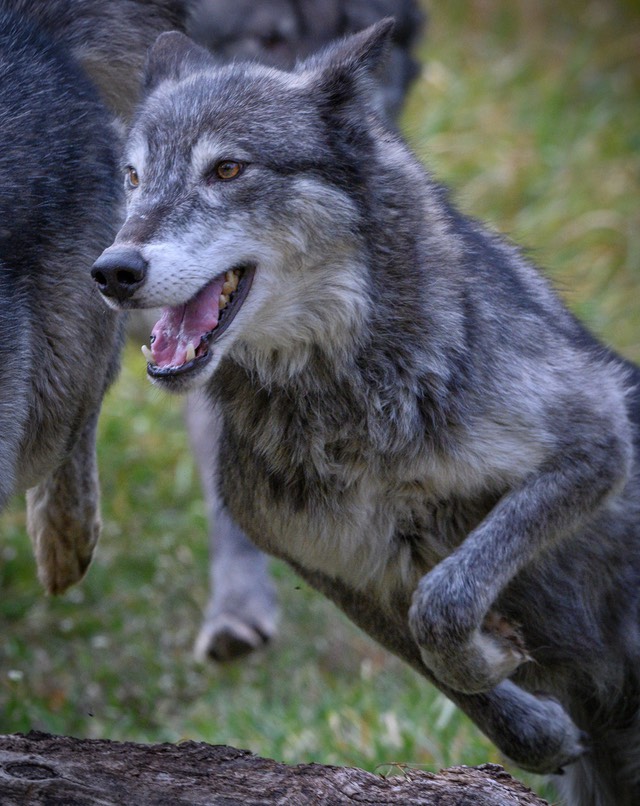
Whoa, that running back turned into an animal...This last shot, by the way, is with the camera that can't focus according to the Internet, the Z7.
Vignetting: Surprise, it's relatively minimal. Indeed, less than my 500mm f/4 wide open. I measure it at about two-thirds of a stop, and at f/8 it's less than a half of a stop.
Chromatic aberration: I didn't really see much of any type of chromatic aberration. Longitudinal is minimal, and lateral is at levels that you're generally not going to worry about.
Linear distortion: minimal here, too (are you sensing a theme). There's a bit of pincushion distortion, but less than a half percent.
Flare: I wasn't able to generate much in the way of the classic PF-type flare (big ugly circular rings from backlights that flare with the fresnel pattern), but I did notice that in strong backlight the performance isn't quite as snappy and contrasty as it is with front light.
Final Words
Nikon has another winner. Most of us fell in love with the truly portable 300mm f/4E PF. Well, now we have to make room in our gear closets for the 500mm f/5.6E PF version, too, and for the same reasons. These are compact, light, highly portable and handholdable lenses that deliver strong optical performance with almost no exceptions.
Yes, both the 300mm and 500mm are pricey lenses due to their exotic and difficult to make PF elements. But in my view they're worth it.
No, you don't get super subject/background separation due to the smaller apertures on the PF lenses. But with proper positioning and careful use, they do just fine for both sports and wildlife shooting.
Both PF lenses are excellent for those times when you want to travel (or hike) lighter but not give up reach and optical quality. There's no way you're going to pry my 400mm f/2.8 from my hands, but I've found plenty of times where I preferred shooting with the 500mm f/5.6E PF.
Some people are asking: 300mm+TC or 500mm? I think that's relatively clear: the 500mm is better than the 300mm PF plus the TC-17E (which gives you a 510mm f/6.3, and you're starting to lose autofocus performance on the DSLRs). If you can get by with 420mm f/5.6 (300mm PF plus the TC-14EIII), that combination is quite good and less expensive than buying the 500mm PF (moreover, it's in stock).
But think about the PF lens and PF lens+1.4x progression for a moment: 300mm f/4, 420mm f/5.6, 500mm f/5.6, 700mm f/8. Those are all usable (the last one being the least so). This is not a lot different than what people were doing with the exotics (e.g. buy a 200/300mm, 500mm, and a TC to get a range of capability). If I can get a little closer and/or need more light, the 300mm f/4 is on the camera. If I'm further away and the light is okay, the 500mm f/5.6 is on the camera. Given that the camera in question for me is a D850 or Z7, the DX crop still gives me 20mp 450mm and 750mm equivalent captures, too. Thus, I'm covered at 300mm, 450mm, 500mm, and 750mm with two bodies with two light lenses.
As much as people have complained about Nikon's choices of focal lengths for the PF lenses ("I wanted a 400mm", or "It should have been a 600mm"), the last sentence in the previous paragraph answers that complaint: Nikon was actually making a reasonable choice here.
There's a reason why you can't find a 500mm f/5.6E PF in stock: it's good. Really good. And more and more people are starting to discover that as the reviews trickle out, so this back-ordered situation is likely to remain for awhile because that big fresnel element isn't made rapidly or in great quantity. If you want a 500mm f/5.6E PF, I'd suggest you get in the wait list at your local dealer sooner rather than later. The more people that see how this lens performs, the more people that are going to want it.
Recommended (2018 to present)
Support this site by purchasing from the following advertiser:
